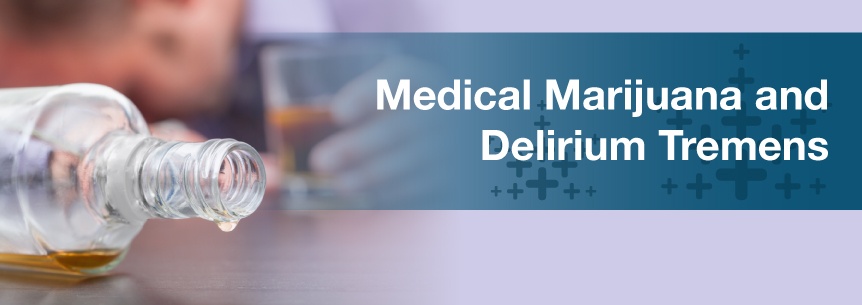
If you’re struggling with alcoholism, you may already know about delirium tremens — and quite possibly already have experienced them. You are likely aware of the disabling effects they can bring on. Delirium tremens symptoms of nausea, vomiting, insomnia, mood changes and even seizures can take a toll on your quality of life. Fortunately, medical marijuana is a treatment option for delirium tremens and can help soften the blow of these and other devastating symptoms.
Much of the evidence that medical marijuana is a viable treatment for delirium tremens is either through experience or through its known capacity for helping specific symptoms. Of the slew of delirium tremens symptoms, all of them have some history of treatment with medical marijuana or testimony from sufferers that it can help. The symptoms of delirium tremens having research regarding treatment with medical marijuana include nightmares, insomnia, nausea and vomiting, headaches and pain.
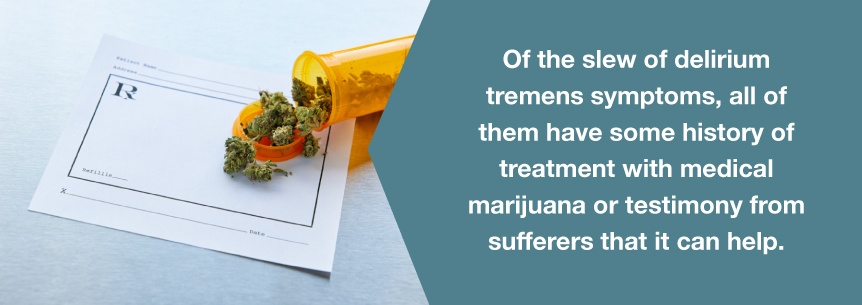
Find A Doctor Find A Dispensary
Various references regarding using cannabis for delirium tremens have shown the herb actually helps individuals through alcohol addiction withdrawal.
In the U.S., doctors prescribed cannabis as a treatment for delirium tremens up until the year 1941 when the possession and use of the herb became illegal. However, now doctors and herbalists alike are slowly starting to use medical marijuana as an alternative in the treatment of the DTs.
Studies from recreational clinical research show individuals might be able to use medical pot to ease noticeable mental symptoms of delirium tremens. Cannabis is an approved alternative medication for calming and mending the mind from aggressive disorders and provides the much-needed healthy sleep of patients.
Marijuana treatment also helps alleviate severe headaches linked with DTs. Cluster and migraine headaches often go along with the delirium tremens “shaking frenzy” and have been effectively treated with medical marijuana. This suggests that other headache types can respond to medical marijuana. It also suggests, as does modern research in pain treatment, that medical marijuana has analgesic effects. It’s also used to combat chronic pain in cancer sufferers. Research suggests it can be used to supplement opiates in chronic pain treatment and it has been used to treat pain for thousands of years.
Medical marijuana can decrease nightmares in anxiety disorders like PTSD. It’s also utilized to treat nausea and vomiting in chemotherapy and AIDS patients. These are well chronicled and FDA supported uses for synthetic medical marijuana. All of the evidence points to the fact that medical marijuana alleviates nausea. This can help those with delirium tremens relax, help their doctors administer medication and help them get the nutrients they need to recover physically.
The herb has pain relieving properties and acts as a sedative, providing you with one natural treatment to combat the symptoms of delirium tremens. Medical marijuana can have a calming effect on patients who react well to it. It can also help with nausea and vomiting. As such, it has potential as a treatment for delirium tremens and has been used to treat the illness by doctors of the past and present.
Essentially, symptoms medical marijuana and delirium tremens can help ease include:
Choosing the best strains of cannabis and delirium tremens treatment is key to relieving your symptoms successfully.
Recommended strains for the various symptoms of DTs are as follows:
The best medical weed strains for treating seizures are typically those low in THC and high in CBD. The combination of the two cannabinoids working together provides CBD’s seizure-reducing effects without THC’s psychoactive side effects.
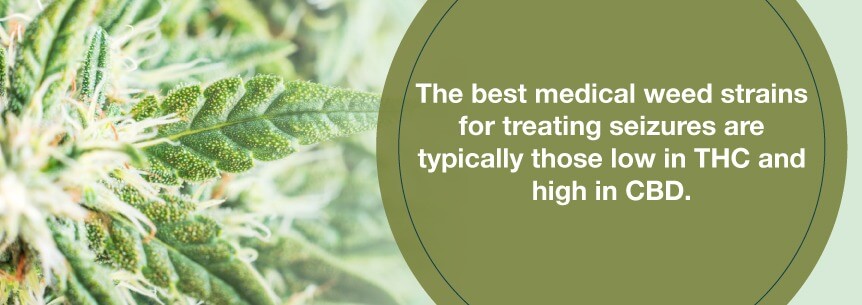
The best strain people have boasted about so far for seizures is Charlotte’s Web.
Indica strains are meant for sleep and promote relaxation, unlike sativa strains, which are more mentally stimulating. Medical cannabis helps people suffering with insomnia to get a better night’s sleep. Some good insomnia-combating strains include:
Most all cannabis strains can help treat nausea, however, there are certain strains that work better in treating nausea than others. Some include:
The best cannabis strains for depression include:
Strains to try for migraine and headache relief include:
Pain-relieving strains include the following:
Remember, what strain or strains work best for someone else may not be optimal for you. Work with your experienced budtender and perform trial and error to find what best helps with your symptoms.
You can consume marijuana for delirium tremens in a variety of administration methods, including:
When one thinks of marijuana, smoking it tends to come to mind. Smoking produces almost instant effects, which is why many individuals prefer this method over others. However, many individuals worry about cannabis smoking’s effect on the respiratory system.
A good alternative to smoking medical pot is vaporization. Vapors reduce the byproducts created because it uses a lower temperature. Marijuana’s chemicals, like with smoking, enter your bloodstream fairly quickly with vaporizing, offering you almost instant relief.
Oils and tinctures use cannabis in concentrations you can add to beverages and food, or you can simply take the oil by itself. You may add the oil to a pill or capsule and swallow it. Either way provides you with fast relief. Control over your dosing is an advantage of cannabis oil and this is especially important if it’s high in CBD levels. When you prepare and dose cannabis oil properly, it is an effective treatment.
Edibles are another alternative to vaping or smoking the herb. You’ll find or can make an array of different cannabis-infused food products and enjoy the medicinal benefits in a tasty treat. Some edible options include:
Keep in mind though, edibles do take a little longer for you to feel the effects.
Studies supporting marijuana as a treatment for delirium tremens is still in its early stages, however, there are signs of improvement. If you decide medical cannabis is an alternative treatment you’d like to try, you’ll first want to consult with a doctor.
Many states are already allowing medical weed as a treatment for seizures. So, if you’re inquiring about medical cannabis for delirium tremens, look no further. We’ll help connect you with hundreds of reliable, screened cannabis doctors all over the country, so you can find one in your area. Schedule an appointment to begin your cannabis treatment today.
Find A Doctor Find A Dispensary
Chances are you’ve heard the abbreviation — DTs — more than you’ve heard of the actual condition delirium tremens. Delirium tremens describes the sudden, often severe, mental and nervous system changes resulting from ceasing alcoholic consumption after periods of heavy drinking.
Also called withdrawal delirium, DTs are a medical emergency, and you should not take them lightly. Delirium tremens have a high mortality rate with between one and four percent of patients hospitalized with the condition dying as a result.
The onset of your delirium tremens symptoms often occurs within one to four days of developing acute alcohol withdrawal, according to The National Institute on Alcohol Abuse and Alcoholism (NIAAA). Those symptoms include:
Most patients who ultimately develop DTs experience alcohol withdrawal symptoms before developing delirium tremens.
Some co-occurring medical conditions may make it more difficult to diagnose and treat delirium tremens, including:
Patients receiving sufficient medical treatment and support have a much lower risk of death from delirium tremens than those who receive no medical care for their conditions.
Symptoms of delirium tremens often serve as diagnostic tools for patients and physicians, especially upon cessation of reduced alcohol intake after prolonged or heavy periods of consumption. These are the symptoms to watch for if delirium tremens is a possibility or a concern in yourself or a loved one:
Sometimes, the symptoms significantly impair normal social, occupational and overall ability to function. It’s more likely to be a result of delirium tremens if there is no other general medical condition they can be attributed to.
The primary component for delirium tremens is a history of heavy alcohol use. Over time, your body becomes dependent on alcohol when you consume large amounts of it daily. Your central nervous system and certain parts of your brain are not able to compensate quickly when the supply of alcohol suddenly stops or is greatly reduced without warning.
People who drink heavily often experience alcohol withdrawal delirium when they:
Some people are at a greater risk for developing delirium tremens including people who have:
If you suspect delirium tremens in yourself or a loved one based on the information above, seek emergency medical help right away.
All delirium tremens symptoms are related to the central nervous system hyperactivity. Some people experience seizures, which usually occur as a single seizure or a flurry of seizures that occur in a short time span.
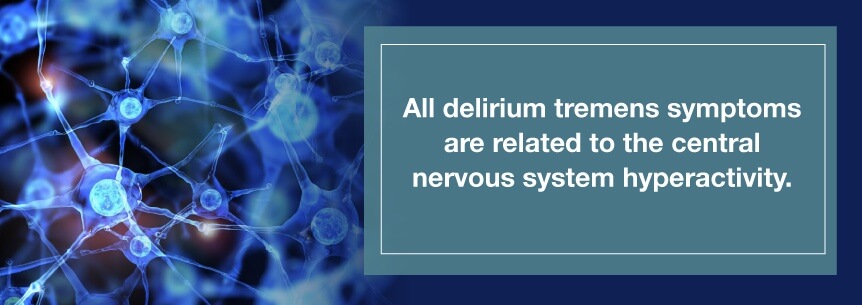
Death occurs in between five and 25 percent of people who develop DTs — this includes individuals who were not hospitalized. That figure is substantially lower than previous mortality rates of 37 percent of patients who experienced alcohol withdrawal syndrome in the early 20th century.
Death from delirium tremens is usually the result of one of the following:
Medical supervision while going through withdrawal delirium dramatically reduces, though cannot eliminate, the risk of death.
While delirium tremens is a serious medical condition, it also indicates a long-term dependence on high volumes of alcohol consumption routinely. This type of alcohol use or abuse is associated with alcoholism, a condition that may require intervention in the form of medical rehab to control the symptoms of delirium tremens while treating the addiction to alcohol.
Immediate mental effects of DTs include:
There may be co-occurring illnesses along with addiction, as well as many health issues related to prolonged periods of high-volume alcohol consumption, including mental health issues that may be, as of yet, undiagnosed.
Delirium tremens is a serious health condition that should not be ignored. The statistics below will help you understand the condition a little better.
One of the problems associated with gathering data and statistical information about DTs is the wide range of language used to identify and diagnose the condition as well as the criteria various medical centers use to confirm a diagnosis of withdrawal delirium.
Delirium tremens is a well-documented condition that has been known since the late 1700s. It wasn’t until 1813, however, that the name, “delirium tremens,” was ascribed to the condition. In the past, there was very little to be done for patients with delirium tremens other than to ensure that they did not hurt themselves or others.
Early treatments for DTs included some of the following:
Fortunately, treatments have evolved in recent years, leading to a greatly improved mortality rate for people experiencing delirium tremens.
As it’s typically a symptom of alcohol withdrawal, continuing to drink liquor can prevent delirium tremens. However, doctors don’t advise this given the amount of alcohol it takes to produce delirium tremens upon cessation is likely to cause debilitating and even deadly health problems. Hospitals use pharmaceuticals to keep the patient calm and to keep seizures and hallucinations under control.
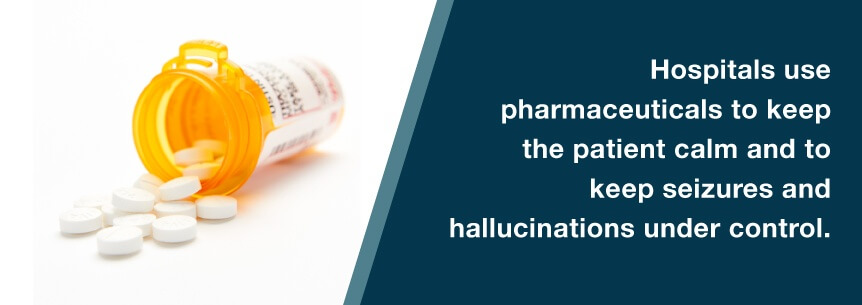
Several medications are used to treat delirium tremens, including:
The Hospitalist reports that benzodiazepines are the most common medications used to treat alcohol withdrawal and delirium tremens in the U.S., though barbiturates are also effective treatments because they are both cross-tolerant with alcohol.
Benzodiazepine medications are preferred treatments for DTs because they rapidly calm patients and produce few adverse side effects.
Side effects of benzodiazepines include:
Phenobarbital, a long-acting barbiturate, offers the added benefit of serving as an anticonvulsant when used to treat delirium tremens. It successfully treats alcohol withdrawal symptoms and has a calming, sedative effect whether administered orally, intramuscularly or intravenously.
Side effects of using barbiturates include:
The sedative effect of both classes of medication helps to suppress the central nervous system hyperactivity that delirium tremens causes. This makes them both effective for treating DTs.
Propofol is another treatment used to treat delirium tremens, especially in patients who aren’t responding adequately to treatment with benzodiazepines or barbiturates. Propofol is often used to maintain sedation for patients in ICU units and provides rapid control of the agitation and autonomic instabilities commonly associated with delirium tremens.
Propofol side effects may include:
Contact a nurse right away if patient experiences:
Propofol does not require tapering off dosages or weaning though some physicians prefer to wean patients from propofol over the course of several hours.
The following are also commonly prescribed, in a medically supervised environment, to treat delirium tremens:
Some side effects of the above drugs include memory and judgment impairment, slow breathing, sleepiness, muscle weakness and lack of coordination.
While benzodiazepines represent the first-line medications of choice for the treatment of delirium tremens, increasing evidence suggests non-benzodiazepine anticonvulsants (NBACs) offer promising options for patients dependent on alcohol. NBACs most studied for this purpose include valproic acid, gabapentin and carbamazepine, with the latter two showing the most compelling research for treating alcohol withdrawal syndrome. Researchers are also studying the usefulness of baclofen and topiramate for alcohol withdrawal syndrome.